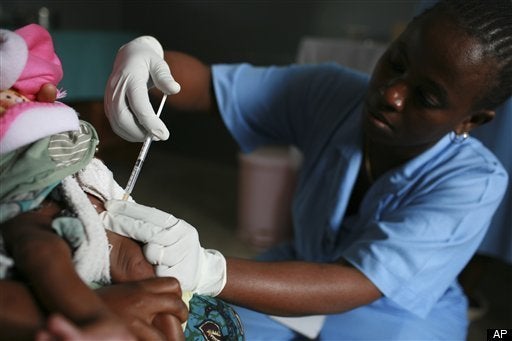
Several major announcements have been made in recent weeks about the expansion of vaccine access to the world's poor. This progress and the "Power of Vaccines" are the subject of a high level discussion today in Washington convened by the Center for Strategic and International Studies (CSIS), featuring USAID Administrator Raj Shah and speakers from NIH, CDC, the GAVI Alliance and Johns Hopkins University.
From rolling out the first diarrhea vaccines in Africa, to doubling the number of low-income countries approved for vaccines against pneumonia, to announcing they will now assist countries introduce vaccines for that prevent cervical cancer, the GAVI Alliance and its partners are tearing down the barriers to vaccine access that have historically divided rich from poor on our planet.
To appreciate how far we've come you need to remember where we started. Consider the situation with pneumococcal conjugate vaccines (PCV) in 2003. At that time, developing country access to these vaccines seemed almost unthinkable. The vaccine had only been routinely used in the U.S. for three years, and the manufacturer was struggling to supply American children who paid top dollar prices. Access to affordable supplies of this vaccine was out of the question. In addition, the World Health Organization (WHO) had not yet recommended the vaccine for use and most developing countries had little appreciation for the burden of pneumococcal disease in their countries. Finally, our track record in vaccine access was generally lame, with 15 years or more passing before poor countries accessed the same vaccines as richer ones.
To their credit, GAVI and its Board recognized the importance of pneumococcal vaccines and established GAVI's PneumoADIP at the Johns Hopkins Bloomberg School of Public Health to accelerate their introduction in the world's poorest countries. With four years of funding and a small, dedicated team, PneumoADIP aimed to establish, communicate and deliver the value of pneumococcal vaccination by providing the evidence that was needed to make this vaccine a priority.
We charted an ambitious course. Working with WHO and academic centers, we established surveillance to monitor disease rates in countries, generated local disease burden estimates and calculated the health and economic impact of investing in the vaccine. We improved the rigor and accuracy of demand forecasts, which helped convince manufacturers that there could be a viable developing country market and laid the groundwork for a more diverse supplier base and better vaccines for GAVI countries. We used the evidence to advocate regionally and globally for vaccine access, so the issue began to appear on the global health agenda.
There were bumps along the way, to be sure, but the hard work paid off. By 2006, the WHO had recommended that all countries introduce PCV for children. By 2007, five donor countries and the Bill & Melinda Gates Foundation had committed over $1.5 billion in financing and by 2009, multiple manufacturers were committed to supplying improved vaccines to developing countries at sharply discounted prices. Most importantly, the countries themselves were demanding the vaccines. Nearly half of the world's poorest countries indicated to GAVI that they wanted to introduce pneumococcal conjugate vaccines before 2015.
In April 2009, I stood with Rwandan health minister Richard Sezibera in a dusty rural field crowded with thousands of local families as he administered the first dose of PCV through the GAVI program. In one year alone, the program in Rwanda has probably prevented as many child deaths as in a decade of the vaccine's use in the USA. Since then, 34 GAVI countries in Africa, Latin America and Asia have followed Rwanda's example.
Recognizing that vaccine access across a range of diseases remains a challenge, we launched the International Vaccine Access Center (IVAC) two years ago. Still based at Johns Hopkins and building off the platform of our PneumoADIP team, we have begun to chart a new, exciting course that takes what we've learned with pneumococcal vaccine and applies it to other vaccine access challenges.
Our team has grown to include more than 30 full time members with expertise in epidemiology, economics, policy analysis, communications, advocacy, and monitoring & evaluation. Our portfolio, once limited to pneumonia vaccines, now includes work on dengue, meningitis and influenza vaccines, and innovations that can improve vaccine delivery and access, has a budget of more than $17 million and represents projects around the globe.
Current or recent vaccine access projects include:
•In Bangladesh, we're studying simple ways to monitor vaccine coverage using biomarkers instead of administrative data and to help us identify communities in which barriers conspire to leave children unprotected.
•In India and Nigeria - the two countries with the most child deaths - we are working with local religious, political and community leaders to ensure that steps toward expanded immunization are locally owned and led and integrated within primary health care packages.
•Seeing that one can buy a Coca-Cola on virtually every corner in Africa but health interventions can be next to impossible to find, we collaborated with McKinsey & Co. to study ways to leverage the success of private companies to deliver health products in remote areas.
•Because cell phones have become commonplace even in the poorest of communities, we're exploring ways that so-called mHealth technologies can be used to remind and incentivize mothers to stay current with their children's immunization schedules.
•And finally, because we know health economics will continue to be a huge issue as countries considers a wealth of health options with a shallow reserve of resources, we're undertaking rigorous cost-effectiveness studies to help guide advocacy work in the years ahead.
At their best, vaccines are tools for social justice that eliminate health inequities -- but only if all people, everywhere have access to these life-saving innovations. The experience with pneumococcal vaccines shows us how the wonky, behind-the-scenes efforts undertaken on a campus in Baltimore can help translate into lives saved in places as far away as Bangladesh and Burundi. Vaccine access is a leading challenge for the Decade of Vaccines. Only with universal access will we have truly harnessed their power.
